- Year: 1949
- Director: Jack Kinney, Clyde Geronimi
- Starring: Bing Crosby
Disney is not exactly known for films that are accurate adaptations, but today’s is an exception—a major exception. Disney’s The Legend of Sleepy Hollow is one of the most accurate adaptations ever made, in both story and the general feel of the tale. It can be easy to put the events of a story on screen (in most cases), but to entirely capture the feel of a story is truly what makes a great adaptation. So why isn’t this held in high acclaim with other animated classics?
Well, for one, it came at an interesting point in history. After their first few animated films, Disney was on top of the world, making the films that are among their most beloved to this day like Fantasia, Pinocchio and Bambi. Then, World War II hit and the studio put out package film to pay the bills. By 1949, they were getting back on track, putting out a film that was two thirty minute films packaged together—The Adventures of Ichabod and Mr. Toad.
This film basically spawned from the fact that Disney wanted to adapt The Wind in the Willows and “The Legend of Sleepy Hollow,” but didn’t have the budget to do full length versions. The two stories really have no thematic connection at all, so it’s kind of jarring that they’re back-to-back. I suppose one takes place at Christmas and the other at Halloween, but even that is pushing it. Eventually, the two were released separately on home video, because if you watch them together you’re basically bearing through the underwhelming Mr. Toad segment to get to Ichabod. On its own, Disney’s Sleepy Hollow has become something of a Halloween classic, but not a legendary film.
Like many versions, the characters don’t really speak, with the special instead being narrated by Bing Crosby. There are a few screams, shrieks and such here and there from the characters, but there is not dialogue. I wouldn’t want it in every story, but I like this approach here. It manages to keep so much of Irving’s beautiful prose without just being someone reading the story. Crosby of course uses his own style, making lighthearted comments about the characters and sort of sing-talking through some parts. It could be dated, but it really just adds to the charm of the whole thing.
Surprisingly, Disney is not afraid to play up the story’s ambiguities. While you might expect them to portray Ichabod as the straight hero and Brom as the villain, they instead insert all of Ichabod’s unattractive qualities from the story, like gluttony, laziness and worst of all, greed.
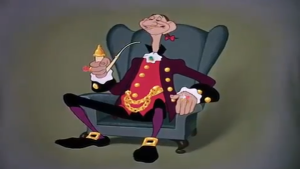
Brom is portrayed as boisterous and immature, but we also see that he isn’t really all bad. What’s amazing is just how much we see of this through silent animation. Brom is a bully sure, but he often shows this boyishness about him that he’ll probably outgrow, and he probably does care about Katrina more than Ichabod does.
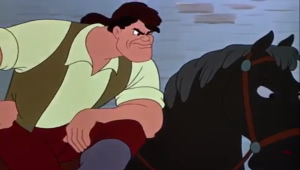
While the short story suggests that Katrina is probably just wooing Ichabod to make Brom jealous, which will lead to him being more committed, that is actually downplayed here. She is shown as getting a little enjoyment out of it, but she is mostly portrayed as naive instead of manipulative. The major change is that she does not break up with Ichabod after the party, showing that her affections for him were most likely genuine. It’s a perfectly fine and even welcome change, as it makes her character less one note and makes the ending even more impactful.
The story is expanded a bit as Brom and Ichabod compete for Katrina’s affections in a slapstick-esque war, which almost breaks into Tom and Jerry or Bugs Bunny territory, but it never feels too derivative or out of place. The character animation is just great here, as Ichabod slips and slides out of situations due to his lanky frame. If the story took itself too seriously, this comedic animation wouldn’t work, but if it went too far on the light, the dark stuff would never work. It brilliantly finds the balance between the two, just like Irving’s story does, and it’s all the better for it.
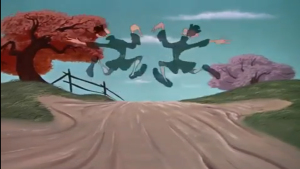
Most of the wartime Disney films had to skimp a little on animation, but it’s clear they were starting to earn money back here, as the backgrounds fully convey the feel of the story. Take the opening for example, as Ichabod walks into town over Bing Crosby’s narration. It’s all green and sunny, and we see the town from afar, including the church. Then, we see a close-up of the church at night, which looks like something out of German Expressionism.
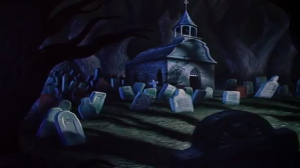
In that one shot, we learn everything we need to know about the town of Sleepy Hollow. It’s a seemingly simple and beautiful town, but there is a hidden darkness to it. There’s a certain Tim Burton adaptation that misses that… but I’m getting ahead of myself. I love how immediately after this, Bing mentions the “best known story” of Sleepy Hollow, and right when we think he’s about to mention the Headless Horseman, he starts the story of Ichabod Crane. In fact, we don’t even learn of the Horseman here until the party at the Van Tassel home.
There are also these little additions here and there that just add to the viewing experiences, especially on re-watches. For example, did you notice that the hay bales at the Van Tassel home are actually shaped like money bags?

I have seen this film probably ten times, and this is literally the first time I noticed that. There’s also this little joke involving Ichabod’s… er… ponytail the first time he sees Katrina.

The music is one of the highlights here, which shouldn’t be all that surprising as it’s Bing Crosby. Since he’s narrating, he can just kind of slide in and out of songs. “Ichabod” is a fun and breezy song introducing our protagonist, with the town pointing out his unique features while still being attracted to them. Of course, when Ichabod leads the town in singing, it’s in Bing Crosby’s traditional style instead of classical psalmody. “Katrina” is a pleasant little ballad about everyone fawning over Katrina van Tassel, and it pops up later when Ichabod whistles it while riding home from the party.
The score switches from comical to easy-going, and the music that plays at the dance is one of the catchiest background tracks I’ve ever heard in a cartoon. However, the scene where Brom starts singing about the Headless Horseman on is the part people really remember, and for good reason. “The Headless Horseman” is a song that perfectly captures the balance of lightheartedness and horror in this story. It’s ridiculously upbeat and catchy, and while of course the lyrics are dark, the music itself has this underlying creepiness to it. The song builds upon itself wonderfully, building up the horror for Ichabod, who is portrayed as every bit as superstitious as he is in the story. I love how this song portrays the Headless Horseman as someone who even scares other ghosts away. What a buildup.
At the beginning of the song, as various characters are telling little tidbits about the Horseman (the closest thing we get to dialogue), we see this guy for all of three seconds.
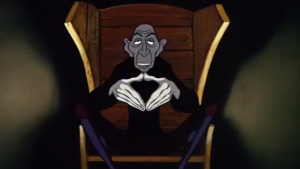
Who the heck is this Nosferatu-looking creep? Does he just sit in that chair with that lighting to look like a Bond villain? With that strange lanky frame and gaunt face, I’m starting to think he might the Ghost of Ichabod Crane future. Look, I get that he’s in this thing for a single moment, but how does no one get creeped out that he’s at this party? Instead of sitting around and telling ghost stories, why don’t they just sit around and look at this guy?
When this song ends, the scene fades to black, and it’s immediately followed by Ichabod riding home. Bing gives a little introductory narration, and then everything cuts out and all we hear are the ambient sounds. As Ichabod rides on, everything scares him. In terms of buildup and payoff, this is an incredibly effective horror scene, and not just for an animated movie. Frogs croak “Ichabod” and “Headless Horseman” and eventually Ichabod realizes that it was just the sounds of nature that scared him, especially the cattails that sounded like hooves. Just when he thinks he’s safe, and he and his horse are having a good laugh, he hears an evil laugh, which ultimately reveals the Headless Horseman in all his horrifying glory.
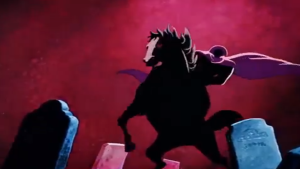
The fake out right before the reveal works so well, because it’s been a pretty creepy scene so far, and first-time viewers without prior knowledge of the story will probably decide that’s all the further a Disney movie would go… but nope, it goes all out. Sure, the chase that ensues is both comical and dark, but it really works. There’s one moment where Ichabod looks down the Headless Horseman’s shirt and comes back looking terrified. What an interesting situation this creates. What did he see? Although the story still seems to imply it could have been Brom, this and a few other factors lean towards the interpretation that the Horseman is real. For example, the horse that he rides is not Gunpowder, Brom’s horse from earlier in the film.
Just like in the story, Ichabod’s ultimate fate is left ambiguous. This is something that is easy to convey in a short story, but for it to be ambiguous in a visual medium? That’s pretty impressive. We see the Horseman throw his flaming pumpkin as Ichabod crosses the bridge, and the pumpkin engulfs the entire screen.
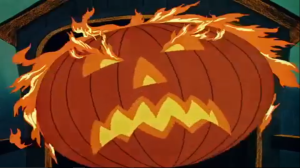
We then cut to the next morning, where all that’s left is Ichabod’s hat and a shattered pumpkin. Bing says that Brom and Katrina got married, and offers the interpretation that Ichabod married a wealthy widow in another town and the one that he was taken away by the Horseman. We do see Ichabod’s “family,” however they look like him.
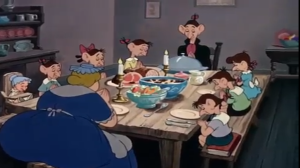
While the short story seems to lean towards the implication that Brom Bones ran Ichabod out of town as a prank, I think this one leads toward the Horseman both being real and killing Ichabod. Regardless, it’s the ambiguity that makes this so effective. The best horror is based in the fear of the unknown, and so many horror films go way too far by showing and telling us everything and therefore ruining the mystique. This may just be a Disney cartoon, but it plays these horror tropes to a t.
Story (28/30 Points)
It adapts the story absolutely wonderfully, filling the 30 minute short without ever feeling rushed or overstaying its welcome. It carries over all of Irving’s ambiguities and shades of gray, and captures both the lighthearted moments and the scary ones.
Leads (26/30 Points)
Ichabod and Brom are incredibly well-rounded characters, showing both their positive and negative traits without downplaying anything. Katrina is pretty good too, but if I have to nitpick, we could maybe have used a little bit more.
Supporting Cast (10/10 Points)
Cast may not be the right word here, as there aren’t really character voices, but Bing Crosby’s narration works even better than you might expect, and it still holds up marvelously. The Headless Horseman is an incredibly memorable character, and it’s because of his animation and that evil laugh. Who is that random creepy guy at the party? I don’t know, but he’s hard to forget.
Experience (28/30 Points)
There are a couple moments where the animation is a bit cheap, but they are really few and far between. It’s really just a few halfway-drawn eyes on a wide shot. Otherwise, the songs are catchy, the animation gorgeous and the atmosphere perfectly autumnal.
FINAL SCORE: 92%
For me, this is the Halloween special. It captures the feel of the fall season as a whole, from the gorgeous scenery to the dark nights. It’s just as great as Washington Irving’s classic story, and it doesn’t pull any punches with the material. Maybe it’s not the classic it should be because it’s not long enough to be a feature or short enough to be a short cartoon. Regardless, it’s one amazing adaptation.
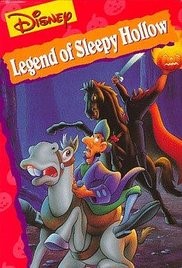
One thought on “The Legend of Sleepy Hollow (1949)”